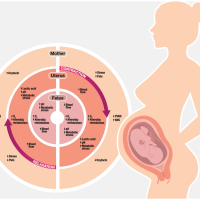The majority of contraceptive methods pose no significant risks to breastfed infants, though certain formulations may adversely affect maternal milk production.
Combined Hormonal Contraceptives: Key Considerations
Combined hormonal contraceptives, which comprise synthetic progesterone (progestin) and estrogen, are available in multiple formulations. These include oral combination birth control pills, transdermal patches (e.g., Ortho Evra), and intravaginal devices like the Nuvaring.
Contraceptives containing estrogen have been associated with reduced breast milk production and shorter breastfeeding durations, even when initiated after lactation is fully established. While not all users experience these effects, studies suggest that only a small proportion of breastfeeding mothers remain unaffected by estrogen-related impacts on milk supply.
Thomas Hale, a leading expert in pharmacology and lactation (author of Medications and Mothers’ Milk), emphasizes heightened caution for individuals with preexisting lactation challenges or those nursing older infants (aged one year or more). For these groups, non-estrogen alternatives, such as progestin-only contraceptives, are generally recommended to minimize risks to breastfeeding outcomes.
Progestin-Based Contraception During Lactation
Progestin-only contraceptives are widely recommended for breastfeeding mothers seeking hormonal birth control. These methods are considered compatible with lactation and are available in multiple formulations, including oral tablets (commonly termed the “mini-pill”), injectables like Depo-Provera, intrauterine devices (IUDs) such as Mirena or Skyla, and subdermal implants like Nexplanon.
Studies suggest that initiating progestin-only contraception after the 6th to 8th week postpartum, at standard doses, generally does not compromise milk supply. However, anecdotal reports indicate that a minority of women may experience reduced lactation, necessitating cautious monitoring when opting for these methods.
For individuals considering long-acting progestin options—such as the injectable (effective for 12 weeks to a year) or IUDs/implants (lasting 3–5 years)—a trial period with the mini-pill is advisable. This allows assessment of hormonal sensitivity; if milk production declines, discontinuation is simpler compared to reversing longer-term methods.
Notably, progesterone-releasing IUDs minimize systemic hormonal exposure by delivering the hormone locally to the uterine lining. This results in significantly lower blood progesterone levels compared to oral or injectable forms, reducing the likelihood of systemic side effects.
Regarding milk composition, high-dose progestin regimens may alter breastmilk’s protein and lactose content, though standard doses typically pose no such risks. Current evidence supports the safety of progestin-only contraceptives at therapeutic levels for breastfeeding infants.
Emergency Contraceptive Pills: Considerations for Breastfeeding Mothers
Emergency contraceptive pills (ECPs) should be reserved as a last-resort option for birth control, regardless of breastfeeding status. Two primary formulations are commercially available: one combining estrogen and progestin, and another containing progestin alone.
Milk supply considerations: Estrogen-containing ECPs may temporarily reduce lactation output in breastfeeding individuals, typically manifesting as a minor decline in milk production within days of use. However, supply usually rebounds afterward. For persistent low supply, lactation support strategies (e.g., increased nursing frequency or pumping) may be necessary.
Safety profile: While both estrogen and progestin formulations are classified as breastfeeding-compatible by the American Academy of Pediatrics (AAP), their use should remain exceptional rather than routine. Progestin-only ECPs are generally preferred due to lower lactation interference risks compared to combination products. The AAP emphasizes that neither hormone poses significant risks to breastfed infants at therapeutic doses.
Clinical guidance: Healthcare providers recommend prioritizing non-hormonal or progestin-only contraceptives (e.g., IUDs, implants) for breastfeeding individuals. ECPs serve as a critical but temporary solution for contraceptive failures or unprotected intercourse, not as a primary birth control method.
Hormonal Contraceptives and Lactation: Key Considerations
Hormonal birth control, particularly formulations containing estrogen, may significantly reduce lactation output in breastfeeding mothers. While estrogen-based contraceptives are more strongly associated with this effect, even progestin-only methods (e.g., the “mini-pill”) have occasionally been linked to transient supply decreases in anecdotal reports.
Infant Safety
No adverse effects on infant health have been documented in long-term studies tracking children up to age 17 whose mothers used hormonal contraceptives during lactation. However, caution is advised for newborns under 6 weeks old, as their immature hepatic systems may struggle to metabolize hormones transferred via breastmilk. Some mothers report increased infant fussiness potentially linked to subtle alterations in milk composition (e.g., reduced protein or lactose levels), though this remains unverified in clinical literature.
Maternal Health Risks
For mothers with a history of gestational diabetes, progestin-only contraceptives may carry elevated risks. A 1998 USC study involving 900 Latina women found a nearly threefold increase in type 2 diabetes incidence among those using progestin-based methods postpartum. While subsequent smaller studies have not replicated these findings, the discrepancy underscores the need for individualized risk assessment, particularly in non-Hispanic populations.
Clinical Recommendations
- Prioritize low-dose hormonal formulations and avoid estrogen-containing contraceptives during early lactation.
- Monitor milk supply and infant weight gain closely. Discontinue hormonal methods temporarily if production declines or growth patterns deviate.
- Consider non-hormonal alternatives like copper IUDs for high-risk populations, including those with diabetes history or persistent lactation challenges.




